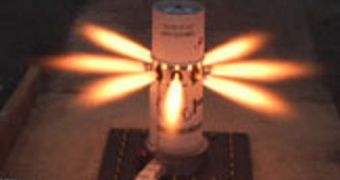Officials at the Alliant Techsystems (ATK) have recently confirmed that the launch abort engine that will need to equip the Orion Crew Exploration Vehicle – as part of Project Constellation – has been fully tested and reviewed. They say that the readiness trials showed that all eight thrusters that equipped the motor functioned within parameters. This is the very first successful, full-scale fire-up of the separation engine, which is to play an important part in the safety of future astronauts going to other planets, Space reports.
This piece of equipment is part of the larger Large Abort System, which incorporates a massive number of new features, designed to boost the protection that human crews have against any potentially fatal mistake or malfunction. There are three main propulsion systems incorporated within their security suite, and two of them are being provided by the ATK. The fact that one of them was already tested in 2009 brings hope that at least these subsystems will be fully operational by 2015 or 2016, when Orion and its ARES I delivery system are scheduled to take off.
“This successful milestone brings Constellation another step closer to flight-ready status and demonstrates progress toward improved flight safety for astronauts that is at the core of Constellation Program success,” the Vice President and General Manager of ATK Tactical Propulsion and Controls, Bart Olson, said two days ago in a press release. In addition, the successful, new test also paves the way for the first full-scale Orion pad-abort test, which Lockheed Martin plans to conduct as early as January or February 2010. Tests are scheduled to take place at the White Sands Missile Range, New Mexico.
The attitude control motor that will go on Orion serves a vital function. In case of an emergency, it will be its job to fire up, and to safely lift the Orion capsule from its ARES I rocket, and steer it away to safety. All these efforts are being made so as to avoid situations similar to the 1986 Challenger accidents, which saw the orbiter being destroyed when a massive explosion ensued due to a series of unfortunate miscalibrations, errors and malfunctions. ARES I and ARES V are touted as having been created with the safety of the astronauts as its core value.

 14 DAY TRIAL //
14 DAY TRIAL //